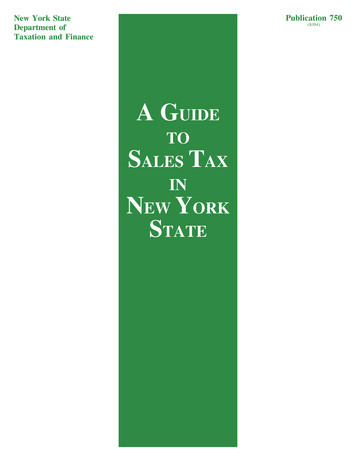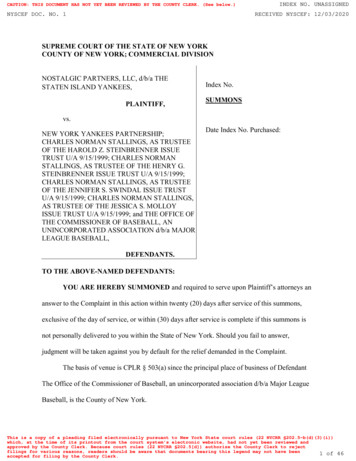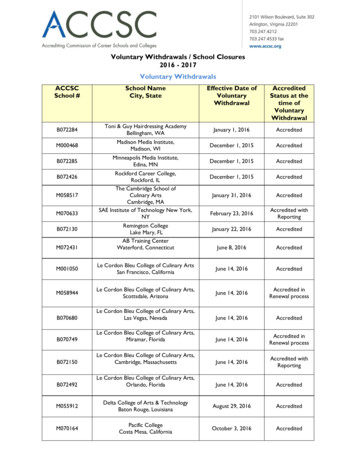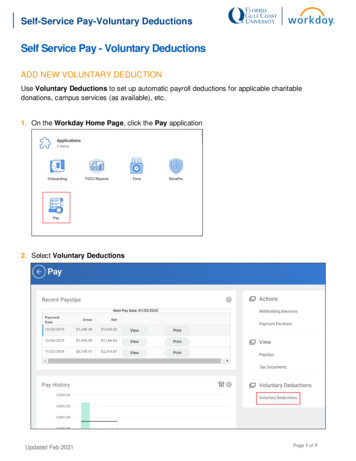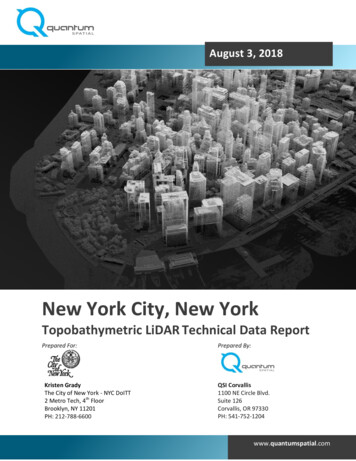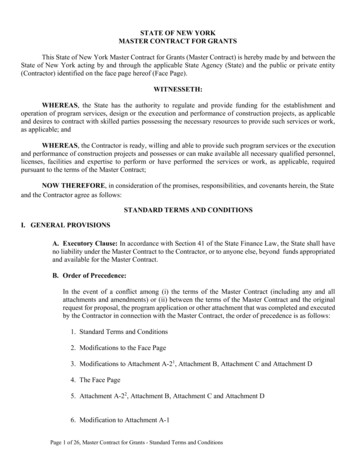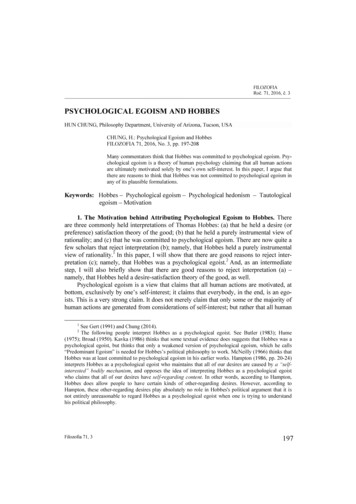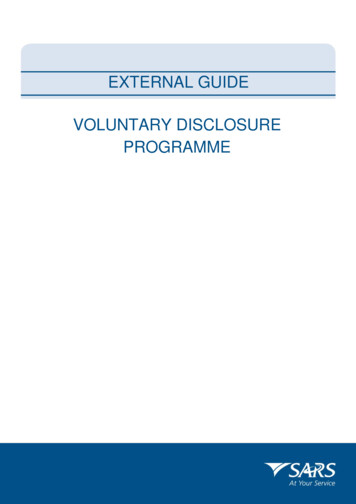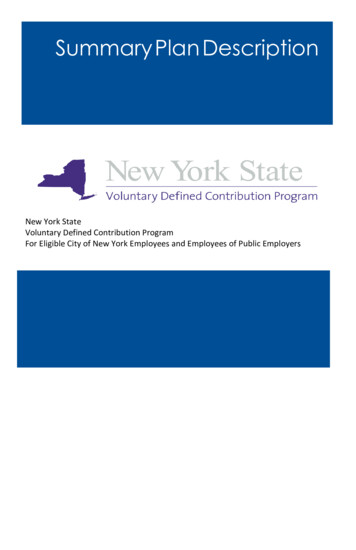
Transcription
Summary Plan DescriptionNew York StateVoluntary Defined Contribution ProgramFor Eligible City of New York Employees and Employees of Public Employers
Table of ContentsEstablishment . 3Eligibility. 4Contribution Rates . 5Social Security(FICA) . 6Vesting . 6Eligibility for City Retiree Health Benefits . 7Eligibility for Management Benefits Fund Retiree Benefits. 7Breaks in Service & Transfers . 7Funding . 8Investment Policy. 8Death Benefits. 9Loans . 9Benefit Payments From Vested Contracts . 9When Distribution Must Begin . 10Making a Cash Withdrawal and Tax Implications . 10Rollover to Another Qualified Retirement Plan or Traditional IRA . 10Rollover Eligibility to the VDC Program From Another QualifiedRetirement Plan or Traditional IRA. 11Rollover Eligibility From the VDC Program to an AlternativeRetirement Plan . 11Your Retirement Benefits if You Become Divorced or Separated . 11Some Other Key Points . 12Investment Provider Information . 13This summary provides a description of some of the key provisions of theNYS Voluntary Defined Contribution (VDC) Program for City of New YorkEmployees and Employees of Public Employers.The State of New York reserves the right to modify, terminate or suspend the program at any time inaccordance with applicable legislation or program guidelines. The State will provide appropriateadvance notice of any change, discontinuance or reduction in benefits.
EstablishmentPursuant to Article 8-B of the New York State Education Law, the StateUniversity of New York (SUNY) Optional Retirement Program (ORP) wasestablished in 1964 as an alternative to the New York State Employees’Retirement System (ERS) and the New York State Teachers’ Retirement System(TRS). Beginning in 1990, the ORP became qualified under Section 401(a) ofthe Internal Revenue Code. Since that time, SUNY’s contributions have beenmade under Section 401(a) and employee contributions have been “pickedup” under Section 414(h)(2) of the Code. The plan year for the ORP is thecalendar year. The original funding choice was TIAA. In 1994, three alternateinvestment providers were designated: MetLife, AIG, and Voya. In 2014,Fidelity was also authorized as an ORP investment provider. MetLife wasremoved in 2017. These companies will, hereinafter, be referred to asinvestment providers.On March 16, 2012, Chapter 18 of the Laws of 2012 was signed into law, whichamended portions of the Retirement and Social Security Law, Education Law,and the Administrative Code of the City of New York. Among other things, thislegislation amended Article 8-B of the Education Law to authorize theparticipation in the SUNY ORP of all unrepresented (non-unionized) employeesof the City of New York and other public employers hired on or after July 1,2013, and earning at the full-time rate of 75,000 or more on an annualizedbasis. This new retirement-benefit option is known as the Voluntary DefinedContribution (VDC) program.Beginning October 1, 2020, the City of New York will be offering the VDCprogram to this newly eligible class of employees. Vesting, investmentproviders, and plan rules follow the SUNY ORP Plan Document and policies.3
EligibilityAll unrepresented and non-civil servant employees hired into or appointed toa full-time and/or part-time position on or after July 1, 2013 with an estimatedannualized full-time salary of 75,000 or more at the date of hire are eligibleto join the VDC program within 30 days of their date of hire.Employees eligible to join the VDC program include: Employees of the City of New York, and Employees of the following public employers (“Public Employers”): New York City Housing Authority (NYCHA) School Construction Authority (SCA) Health Hospitals (H H)In order for an employee to participate in the VDC program, the employeemust enroll in the program: Within 30 days of the employee’s hire date.Once an election to join the VDC program is made, the employee’s enrollmentis irrevocable.If the eligible employee decides not to participate in the VDC program, theemployee must complete the “VDC Declination Form” and provide it to theiremployee’s agency Human Resources representative. Failure by employees,who were eligible and/or previously notified via e-mail by their HumanResources representative regarding their eligibility for the VDC program totimely enroll or submit a VDC declination form will be deemed as havingdeclined participation in the VDC program.If an employee fails to make a timely election to join the VDC program, theemployee is ineligible to join the VDC program but is still eligible to join thedefined-benefit NYC retirement system available for the employee’s title.An employee hired after July 1, 2013 who is a member of a City definedbenefit pension system is not eligible to participate in the VDC program as ofits rollout.4
Contribution RatesThe VDC program is a defined contribution retirement program. Benefits aredetermined by the amount contributed each year and investment returns. Thecontribution rates to the VDC program are as follows:EMPLOYER CONTRIBUTIONEmployer contributions for the first year of employment are not made untilthe employee has fulfilled the vesting requirement discussed below. Anemployer contribution of 8% of salary will be made for the duration ofemployment thereafter.EMPLOYEE CONTRIBUTIONAn employee contribution will be required for the duration of employmentbased upon estimated gross annual wages in a given calendar year,as follows:Wages of 55,000.01 to 75,0004.5%Wages of 75,000.01 to 100,0005.75%Wages of more than 100,0006%If an employee’s annualized full-time salary falls below 75,000 at any timeduring the employee’s participation in the VDC program, the employee retainsmembership in the program subject to the following required employeecontribution percentage rates:Wages of 45,000 or less3%Wages of 45,000.01 to 55,0003.5%Wages of 55,000.01 to 75,0004.5%VDC program employee contributions are made through payroll deductions ona pre-tax basis. Contributions are not subject to federal income tax untilwithdrawn but are subject to state and local income taxes in the year in whichthey are made. Employee contributions must be reported on the employee’sstate and local income tax return. All earnings on contributions are taxdeferred until they are withdrawn.All contributions are made based upon Internal Revenue Service (IRS)compensation and contribution limits, which are determined annually andmay affect the employee’s voluntary contributions to the NYC DeferredCompensation 401(k) Plan.5
Social Security (FICA)The City of New York and Public Employers will deduct Social Security taxesfrom the employee’s pay during VDC program participation. Employees areadvised that if the Social Security Administration (SSA) and the IRS determinethat the VDC program is an alternative to Social Security and not otherwisesubject to mandatory Social Security coverage, then VDC program participantswill be ineligible for Social Security benefits for the period of theirparticipation. In that event the Social Security tax deductions made from anemployee’s pay during VDC program participation may be refundable from theIRS to the extent permitted by federal law.VestingContributions will begin upon an employee’s enrollment in the VDC program,but are held by the City of New York in escrow until completion of the vestingperiod. A participant is vested upon completion of 366 days of service fromenrollment in the VDC program.If a participant is on leave without pay at any time during the vesting period,then the vesting period will be extended by the length of the leave withoutpay, in order to meet the required contributions.A participant who does not complete the vesting period is entitled to adistribution of participant’s contributions plus interest.Once vested, the City of New York or Public Employer will make a single lumpsum contribution of applicable escrowed employee contributions, employercontributions and interest to TIAA, as common remitter for the VDC program,who will in turn allocate the funds to the participant’s selected VDCinvestment provider(s).Upon completion of the vesting period, the participant has full and immediatevesting in all retirement and death benefits provided by the retirementannuities purchased through the employee and the employer contributions.The vesting period does not apply to the following employees, who areconsidered immediately vested in the VDC program: Employees who come to eligible employment with vested employer fundedretirement contracts from any of the VDC investment providers (Fidelity,TIAA, AIG, or Voya)6
Employees with at least 366 days of service with any public employerwithin New York State Employees of the City of New York and Public Employers who were hiredon or after July 1, 2013, and have already completed 366 days of service.Eligibility for City Retiree Health BenefitsAn employee of the City of New York or Participating Employers who elects toenroll in the VDC program is not eligible to receive NYC retiree health benefitson the basis of employment during which the employee participates in theVDC program, even if the employee remains employed for 10 years of longer,unless the employee has a previously vested membership with any NYCdefined benefit pension fund or retirement system with sufficient duration toindependently render the employee eligible to receive retiree health benefits.Eligibility for Management Benefits Fund (MBF)Retiree BenefitsAn employee of the City of New York or Participating Employers who elects toenroll in the VDC program is not eligible to receive MBF retiree benefits on thebasis of employment during which the employee participates in the VDCprogram, even if the employee remains employed for 10 years of longer,unless the employee has a previously vested membership with any NYCdefined benefit pension fund or retirement system with sufficient duration toindependently render the employee eligible to receive MBF retiree benefits.Breaks in Service & TransfersAn employee who participates in the VDC program (whether vested or not)and leaves NYC public service is eligible to participate upon return to Cityservice subject to the VDC program requirements. A break in City service isdefined as retirement or being off City payroll for 45 or more days and doesnot include leaves of absence such as terminal leave, child care leave,sick leave, unpaid leave, paid family leave, FFCRA, or Workers’ Compensationleave.If an employee transfers agencies within the City of New York or to a PublicEmployer, they must submit a VDC Program Change Form to the VDC ProgramAdministrative Office prior to their transfer in order to continue payrolldeductions. (Provided the employee remains eligible for continuedparticipation in the VDC program). The VDC Change Form is located on theVDC Program portion of the OLR website, located at vdc-change-form.pdf(nyc.gov)7
An employee currently participating in the VDC program becomes ineligiblefor continued participation in the VDC program upon the following: taking a position in a represented title, being appointed into a permanent civil service title.If the employee did not vest in the VDC program due to the above, theemployee is eligible to buy back service credit in a City defined benefit pensionsystem for the time period the employee was enrolled in the VDC Program.An employee vested in the VDC Program is not eligible to buy back servicecredit in a City defined benefit pension system for the time period theemployee participated in the VDC Program.FundingThis is a defined contribution retirement program under which individualcontracts, providing retirement and death benefits for or on behalf of electingemployees, are purchased from any of the approved investment providers(Fidelity, TIAA, AIG, and Voya). Contracts are issued to and become theproperty of the electing employee. Payments are made in accordance with thecontracts, and the employer is not liable for the payment of benefits providedunder such contracts.VDC participants may elect one or more of the investment providers. Eachinvestment provider has a variety of approved investment options.Contributions are initially directed to TIAA as common remitter for theprogram. At the VDC participant’s election, TIAA will automatically transfer all(100%) or a specified percentage of contributions to any of the other approvedinvestment providers selected each pay period. Participants may also transferassets between authorized investment providers, subject to investmentprovider policies and any restrictions applicable to the specific investmentfunds selected. There is no charge for in-plan transfers.Investment PolicyFunds available for investment through the New York State Voluntary DefinedContribution Program are carefully monitored and may be modified whenchanges are deemed necessary and appropriate by the SUNY ORP. Fundreviews are conducted on a quarterly basis by SUNY ORP and any concerns areaddressed with the VDC investment providers. The primary overall investmentobjective for the NYS VDC program is that the investment options offeredinclude funds having diverse risk and return expectations so that eachparticipant may construct a portfolio that can be expected to meet his or her8
individual needs. The funds offered through the NYS VDC program were notselected or approved by the City of New York or the Public Employers, and theCity of New York cannot advise employees who participate in the VDCprogram on investment options and/or decisions.Death BenefitsIf you are vested and die before you have annuitized all funds in yourcontracts, any unannuitized balance is available to your beneficiary in a lumpsum, unless you have chosen another payment option for your beneficiary, asdescribed in your annuity contract. Your beneficiary may also contact theinvestment providers for additional options. Your entire balance mustnormally be distributed to your beneficiary by December 31 of the 5thcalendar year after your death. If elected, death benefits may be payable overthe life expectancy of the beneficiary, if the distribution of benefits begins nolater than December 31 of the calendar year, immediately following thecalendar year of your death. If the designated beneficiary is your spouse, thecommencement of benefits may be deferred until December 31 of thecalendar year when you would have attained age 72, had you lived. If you dieafter all funds have been annuitized, any additional payments will bedetermined by the annuity option you selected at retirement. There is nodeath benefit if you are not vested. If a beneficiary is a corporation,association or an estate, a single lump-sum payment will be made.If you are not vested and you die, your contributions plus interest will be paidto your beneficiary.LoansCity employees are not eligible for a loan from the VDC program.Benefit Payments From Vested ContractsYour investment provider(s) will provide you with assistance in selecting anannuity option(s) in settlement of annuity contracts. You can receive adistribution at any age from your contracts following termination fromemployment with the City of New York or Public Employer.9
When Distribution Must BeginFederal tax law requires that minimum distribution of retirement incomebegin by April 1 of the calendar year following the latter of:1. the calendar year in which you reach age 72 and if you are severed fromservice, or2. the calendar year in which you terminate employment.If the required minimum amount is not distributed, the IRS applies a tax penaltyequal to 50% of the difference between the amount that should have beendistributed and the amount actually distributed.An annuity is based on the accumulated value of employee and employercontributions. At the age of retirement, you may receive either a fixed orvariable annuity or both.Making a Cash Withdrawal and Tax ImplicationsWhen your NYC public employment ends, you may surrender your contractsfor the cash value, subject to IRS regulations. Cash distributions are subject toordinary federal income taxes and may be subject to an additional IRS 10%early withdrawal tax penalty. The investment provider must withhold 20%from any single lump-sum benefit paid to you, and send it to the IRS forfederal income tax. The IRS will apply the amount toward income taxes due.An IRS 10% tax penalty will generally apply to cash withdrawals made beforeage 59 1/2, unless you have medical expenses exceeding the tax-deductiblelimit or you become disabled, die or retire after attaining age 55. There is noapplicable IRS 10% tax penalty applied to payments made to children or to adivorced spouse in accordance with a qualified domestic relations order.Distributions from the VDC program are generally exempt from New YorkState Income taxes. This information is not intended to be relied upon as taxadvice. You are encouraged to consult a tax advisor.Rollover to Another Qualified Retirement Planor Traditional IRASince 2002, the IRS has allowed the rollover of distributions between differenttypes of retirement plans (e.g., to or from 401(a), 401(k), 403(a), 403(b),457(b) and Traditional IRA plans). In order to rollover an amount to anemployer sponsored plan, you must be separated from service and that planmust permit the rollover into the plan. You should contact the investmentproviders for more information on eligibility and taxation of rollovers.10
Rollover Eligibility to the VDC Programfrom Another Qualified Retirement Planor Traditional IRAThe VDC program does not accept rollovers from other retirement plan(s),Traditional IRAs or Roth IRAs.Rollover Eligibility from the VDC Program to anAlternative Retirement PlanA rollover is a tax-free transfer of assets from a retirement plan to either aTraditional IRA or another employer’s retirement plan. You are not eligible toroll money out of the VDC program until after separation from service. Carefulconsideration of outside investment fees and the tax consequences of bothtransfers and ultimate distributions should be discussed with your tax advisorprior to completing any rollovers from the VDC program.A direct rollover will transfer funds from the VDC program directly to an IRAtrustee or to the trustee of the retirement plan of the new employer (if theplan permits this type of rollover). You do not take receipt of the funds and arenot subject to any required income tax withholding.An indirect rollover is a payment made to you, not directly to the recipient ofthe plan or IRA. A 20% statutory tax withholding is required. In order to qualifyas a rollover, the funds must be deposited into another qualified retirementplan or to a Traditional IRA account within 60 days of receipt.Failure to deposit the investment into an IRA or qualified plan will result in ataxable distribution. Early distribution penalties may also apply.You cannot roll over to a Roth IRA. However, you may be able to convert theassets to a Roth IRA from a Traditional IRA based on IRA guidelines. Contactthe investment provider for more information.Your Retirement Benefits if You BecomeDivorced or SeparatedIn the event that a judgment, decree or court order establishes the rights ofanother person to your benefits under the VDC program, and where there is aqualified domestic relations order, payments will be made by the investmentproviders in accordance with that order. A court order may preempt the usualrequirement that your spouse be considered your primary beneficiary for aportion of the accumulation. Additional information can be obtained from theapplicable investment provider. All qualified domestic relations orders for aVDC contract should be sent to your investment provider(s).11
Some Other Key Points The investment providers offer mobility of retirement benefits as annuitycontracts and are fully vested with the individual immediately upon issue.This, coupled with the coordination with the defined contribution plans ofmany other employers throughout the nation, permits NYC publicemployees electing the VDC program to continue their contracts if theyleave NYC public employment. Professional guidance and investment advice services are available throughall authorized investment providers within the VDC program at no cost toparticipants. Should you elect the VDC program and at a later date elect a differentretirement system for which you become newly eligible, you will not bepermitted to establish credit in that retirement system for any service forwhich employer contributions under the VDC program were made on yourbehalf. Benefits are payable in accordance with contracts issued by privateinsurers, and are not protected against impairment under the New YorkState Constitution.12
Investment Provider GRichard Grofsick, Advisor 518-783-6464Voya800-438-1272Additional program information and resources are available on the NYS VDCweb site at: http://www.vdc.ny.gov13
PLAN ADMINISTRATOR:Michael ConsorteThe State University of New YorkOffice of University-wide BenefitsState University PlazaAlbany, New York 12246(518) 445-4094michael.consorte@suny.edu
VDC program employee contributions are made through payroll deductions on a pre-tax basis. Contributions are not subject to federal income tax until withdrawn but are subject to state and local income taxes in the year in which they are made. Employee contributions must be reported on the employee's state and local income tax return.



